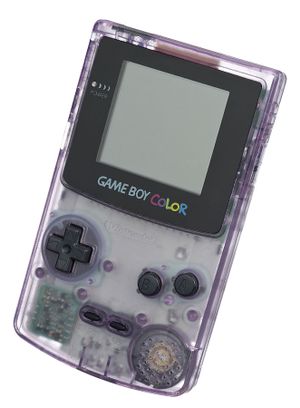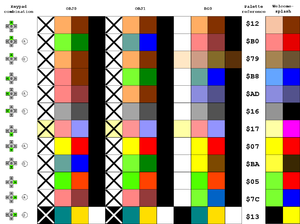Game Boy Color
 | |
 Atomic Purple version of the Game Boy Color | |
| Manufacturer | Nintendo |
|---|---|
| Product family | Game Boy line |
| Type | Handheld game console |
| Generation | Fifth generation |
| Release date |
JP: October 21, 1998 NA: November 18, 1998 EU: November 23, 1998 AUS: November 27, 1998 |
| Retail availability | 1998–2003 |
| Discontinued | March 23, 2003 |
| Units sold | Worldwide: 118.69 million, including Game Boy units |
| Media | ROM cartridge |
| CPU | Sharp LR35902 core @ 4.19/8.38 MHz |
| Display | LCD 160 x 144 pixels, 44 mm × 40 mm (1.7 in × 1.6 in) |
| Online services | Mobile System GB |
| Best-selling game | Pokémon Gold and Silver, approximately 14.51 million combined (in Japan and the USA). |
| Backward compatibility | Game Boy |
| Predecessor | Game Boy |
| Successor | Game Boy Advance |
Contents
Introduction
The Game Boy Color (GBC) is a handheld game console manufactured by Nintendo, which was released on October 21, 1998 in Japan and was released in November of the same year in international markets. It is the successor of the Game Boy.
The Game Boy Color features a color screen. It is slightly thicker and taller and features a slightly smaller screen than the Game Boy Pocket, its predecessor. As with the original Game Boy, it has a custom 8-bit processor made by Sharp that is considered a hybrid between the Intel 8080 and the Zilog Z80. The spelling of the system's name, Game Boy Color, remains consistent throughout the world with its American English spelling of color.
The Game Boy Color's primary competitors in Japan were the grayscale 16-bit handhelds Neo Geo Pocket and the WonderSwan, though the Game Boy Color outsold these by a wide margin. SNK and Bandai countered with the Neo Geo Pocket Color and the Wonderswan Color respectively but this did little to change Nintendo's sales dominance. With Sega discontinuing the Game Gear in 1997, the Game Boy Color's only competitor in the United States was its predecessor, the Game Boy, until the short-lived Neo Geo Pocket Color was released in August 1999. The Game Boy and Game Boy Color combined have sold 118.69 million units worldwide making it the 3rd best selling system of all time. It was discontinued in 2003, shortly after the release of the Game Boy Advance SP.
Specifications
Summary
The technical specifications for the console are as follows:<ref name="technical specification">"Nintendo Game Boy Color Console Information – Console Database". ConsoleDatabase.com. Retrieved 2011-02-19.<templatestyles src="Module:Citation/CS1/styles.css"></templatestyles></ref>
- Main processor: Sharp Corporation LR35902 (based on the 8-bit Zilog Z80)
- Processor speed: 1.0485 (speed of original Game Boy) or 2.097 MHz (two processor modes)
- Resolution: 160 × 144 pixels (10:9 aspect ratio, same aspect ratio and resolution as the original Game Boy)
- Palette colors available: 32,768 (16-bit)
- Colors on screen: Supports 10, 32 or 56
- Maximum sprites: 40 total, 10 per line, 4 colors per sprite (one of which being transparent)
- Sprite size: 8×8 or 8×16
- Tiles on screen: 512 (360~399 visible, the rest are drawn off screen as a scrolling buffer)
- Audio: 2 square wave channels, 1 wave channel, 1 noise channel, mono speaker, stereo headphone jack
- RAM: 32 kB
- VRAM: 16 kB
- Power:
- internal: 2 AA batteries, up to 10 hours of gameplay
- external: 3V DC 0.6W (2.35mm × 0.75mm)
- indicator: Red LED
- Input:
- 8-way Control Pad
- 4 buttons (A, B, Start, Select)
- Volume potentiometer
- Power switch
- Serial I/O ("Link cable"): 512 kbit/s with up to 4 connections in serial
- Infra-red I/O: Less than 2 m distance at 45°
- Cartridge I/O
- Dimensions:
- Metric: 133.5 × 78 × 27.4 mm
- Imperial: 5.25 × 3.07 × 1.07 in
- Weight: 138 g<ref>"Technical data". Nintendo of Europe GmbH (in English). Retrieved 2018-02-04.<templatestyles src="Module:Citation/CS1/styles.css"></templatestyles></ref>
Game Paks manufactured by Nintendo have the following specifications:
- ROM: 8 MB maximum
- Cartridge RAM: 128 kB
The processor, which is a Z80 workalike made by Sharp with a few extra (bit manipulation) instructions, has a clock speed of approximately 8 MHz, twice as fast as that of the original Game Boy. The Game Boy Color also has three times as much memory as the original (32 kilobytes system RAM, 16 kilobytes video RAM). The screen resolution was the same as the original Game Boy, which is 160×144 pixels.
The Game Boy Color also featured an infrared communications port for wireless linking. The feature was only supported in a small number of games, so the infrared port was dropped from the Game Boy Advance line, to be later reintroduced with the Nintendo 3DS, though wireless linking (using Wi-Fi) would return in the Nintendo DS line. The console was capable of showing up to 56 different colors simultaneously on screen from its palette of 32,768 (8×4 color background palettes, 8x3+transparent sprite palettes), and could add basic four-, seven- or ten-color shading to games that had been developed for the original 4-shades-of-grey Game Boy. In the 7-color modes, the sprites and backgrounds were given separate color schemes, and in the 10-color modes the sprites were further split into two differently-colored groups; however, as flat black (or white) was a shared fourth color in all but one (7-color) palette, the overall effect was that of 4, 6 or 8 colors. This method of upgrading the color count resulted in graphic artifacts in certain games; for example, a sprite that was supposed to meld into the background would sometimes be colored separately, making it easily noticeable. Manipulation of palette registers during display allowed for a rarely used "high color mode", capable of displaying more than 2,000 colors on the screen simultaneously.<ref name="aloneinthedark">"First Alone in the Dark Screenshots for Game Boy Color". IGN. 4 August 2000. Retrieved 24 March 2015.<templatestyles src="Module:Citation/CS1/styles.css"></templatestyles></ref>
Color palettes used for original Game Boy games
| Directional pad | Action button | ||
|---|---|---|---|
| None (default) | A | B | |
| Up | Brown | Red | Dark brown |
| Down | Pastel mix | Orange | Yellow |
| Left | Blue | Dark blue | Grayscale |
| Right | Green | Dark green | Inverted |
For dozens of popular Game Boy titles, the Game Boy Color has an enhanced palette built in featuring up to 16 colors - four colors for each of the Game Boy's four layers.<ref>Disassembling the GBC Boot ROM</ref> If the system does not have a palette stored for a game, it defaults to a palette of green, blue, salmon, black, and white. However, when the user turns on the system, they may choose one of 12 built in color palettes by pressing certain button combinations (namely a direction key and optionally A or B) while the Game Boy logo is present on the screen.
These palettes each contain up to ten colors.<ref>"Changing the Color Palette on Game Boy Advance Systems". Customer Service. Nintendo. Retrieved 2009-01-04.<templatestyles src="Module:Citation/CS1/styles.css"></templatestyles></ref> In most games, the four shades displayed on the original Game Boy would translate to different subsets of this 10-color palette, such as by displaying movable sprites in one subset and backgrounds, etc. in another. The grayscale (Left + B) palette produces an appearance similar to that experienced on the original Game Boy.
Partial list of games with special palettes
- Donkey Kong (Game Boy)
- Kirby's Dream Land
- Kirby's Dream Land 2
- Kirby's Pinball Land
- Metroid II: Return of Samus
- Pokémon Red and Blue
- Pitfall!
- Super Mario Land
- Super Mario Land 2: 6 Golden Coins
- Tetris (Game Boy)
- Wario Land: Super Mario Land 3
- Golf (Game Boy)
- Pokémon Yellow (original Game Boy version)
Hi-Color Mode
A few games used a technical trick to increase the number of colors available on-screen. This "Hi-Color mode" is a mode used by the Italian company 7th Sense s.r.l. among others, and can display more than 2000 different colors on the screen. Some examples of games using this trick are The Fish Files, The New Addams Family Series and Alone in the Dark: The New Nightmare.<ref name="aloneinthedark"/><ref name="Albatross">Albatross, Zen. "Game Boy Games That Pushed The Limits of Graphics & Sound". Racketboy. Retrieved 24 March 2015.<templatestyles src="Module:Citation/CS1/styles.css"></templatestyles></ref>
Cartridges
Games that are designed specifically for the Game Boy Color are housed in clear-colored cartridges and are shaped slightly different from original Game Boy games. These games would display a warning message and refuse to play if used in older Game Boy models. Games that are designed for the Game Boy Color, but which also include backwards-compatibility with the previous Game Boy systems, are shaped like original Game Boy games, but usually have black colored cartridges. Pokémon Gold and Silver are also examples of Game Boy Color games that work on an original Game Boy system. The clear-colored Game Boy Color cartridges will function correctly only when used in a Game Boy Color or a later model (a Game Boy Advance, Game Boy Advance SP, or Game Boy Player).
Game Boy Color exclusive games are housed in clear-colored cartridges, referred to as "Game Pak" cartridges.<ref name="NOA GP support">"Game Pak Troubleshooting - All Game Boy Systems". Nintendo of America customer support. Retrieved 2017-09-27.<templatestyles src="Module:Citation/CS1/styles.css"></templatestyles></ref> They are shaped differently from original Game Boy games. When inserted into an original Game Boy, these translucent cartridges prevent the system from turning on due to a missing notch present in original Game Boy cartridges that prevent the cartridge from being removed once powered on (barring the Rumble Pack games or Kirby Tilt 'n Tumble<ref>"Kirby Tilt & Tumble - Cartridge". www.vgfacts.com (in English). Retrieved 2018-06-28.<templatestyles src="Module:Citation/CS1/styles.css"></templatestyles></ref>). While the Game Boy Pocket, Super Game Boy, Super Game Boy 2 and the Japanese-exclusive Game Boy Light do power on with a Game Boy Color exclusive cartridge inserted, these games display a warning message stating that a Game Boy Color system is required and refuse to play. In the cases of Chee-Chai Alien<ref>"プレイ日記 ゲームボーイ最強伝説 ちっちゃいエイリアン 近所のオバチャンに聞いたら「あのメグ・ライアンが絶賛した」とか言っていた!??". valken.obihimo.com. Retrieved 2018-06-28.<templatestyles src="Module:Citation/CS1/styles.css"></templatestyles></ref><ref>"中古 [ゲーム/GB] ちっちゃいエイリアン (ゲーム... - ヤフオク!". ヤフオク! (in 日本語). Retrieved 2018-06-28.<templatestyles src="Module:Citation/CS1/styles.css"></templatestyles></ref> and Pocket Music<ref>"Gameboy Genius » Blog Archive » Pocket Music GBC version GBA fix". blog.gg8.se. Retrieved 2018-06-28.<templatestyles src="Module:Citation/CS1/styles.css"></templatestyles></ref>, it however did power on with Game Boy Advance and Game Boy Advance SP, these games also display a warning message stating that a Game Boy Color system is also required and also refuse to play. Games that are designed for the Game Boy Color, but which also include backward compatibility with the Game Boy, Game Boy Pocket, Super Game Boy, Super Game Boy 2 and the Japanese-exclusive Game Boy Light, use the same cartridge shape as original Game Boy games, but are typically black and never gray. In some colorized versions of games like R-Type DX, it only managed to get the monochrome versions and not the full color versions if you're playing on Game Boy, Game Boy Pocket, Super Game Boy, Super Game Boy 2 and Game Boy Light.
Colors produced
The logo for Game Boy Color spelled out the word "COLOR" in the five original colors in which the unit was manufactured. They were named:
- Berry (C)
- Grape (O)
- Kiwi (L)
- Dandelion (O)
- Teal (R)
Another color released at the same time was "Atomic Purple", made of a transparent purple plastic that was also used on the color-respective Nintendo 64 controller.
Other colors were sold as limited editions or in specific countries.



